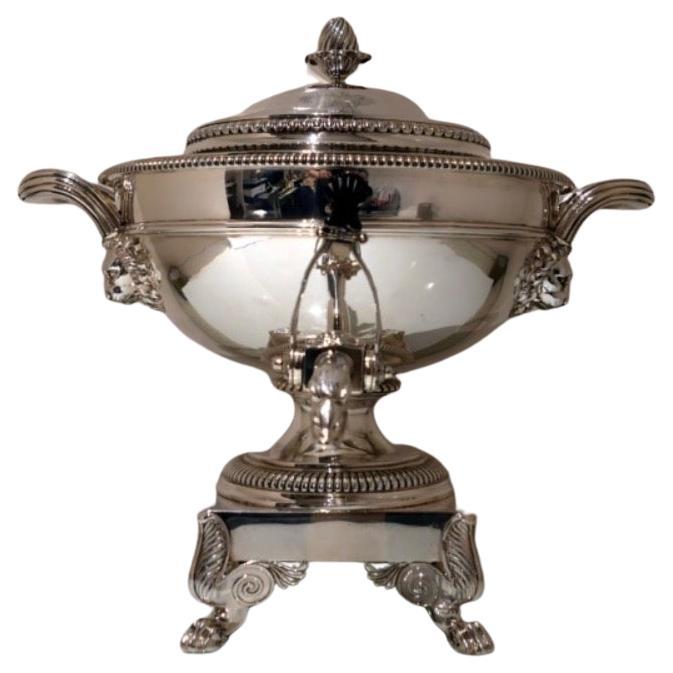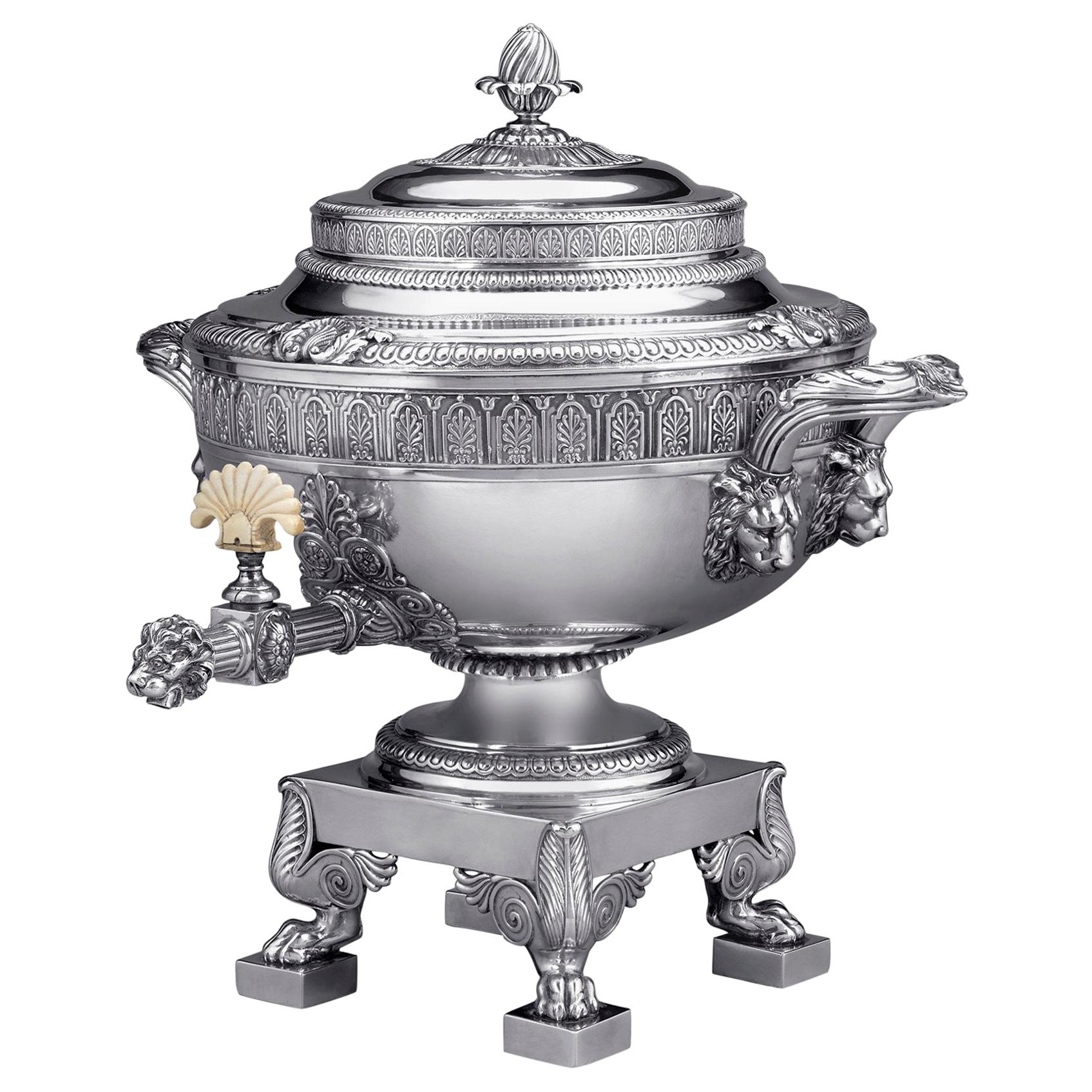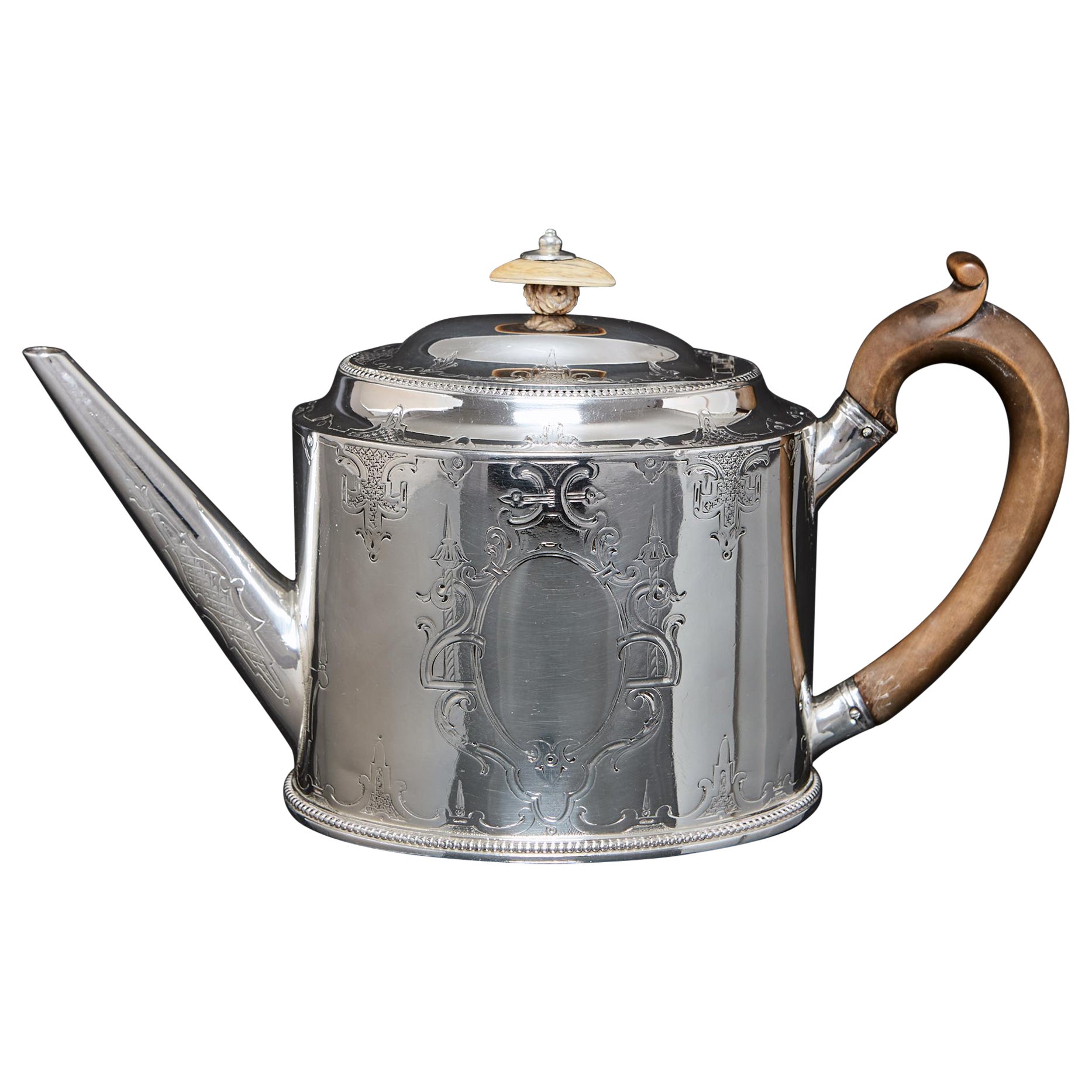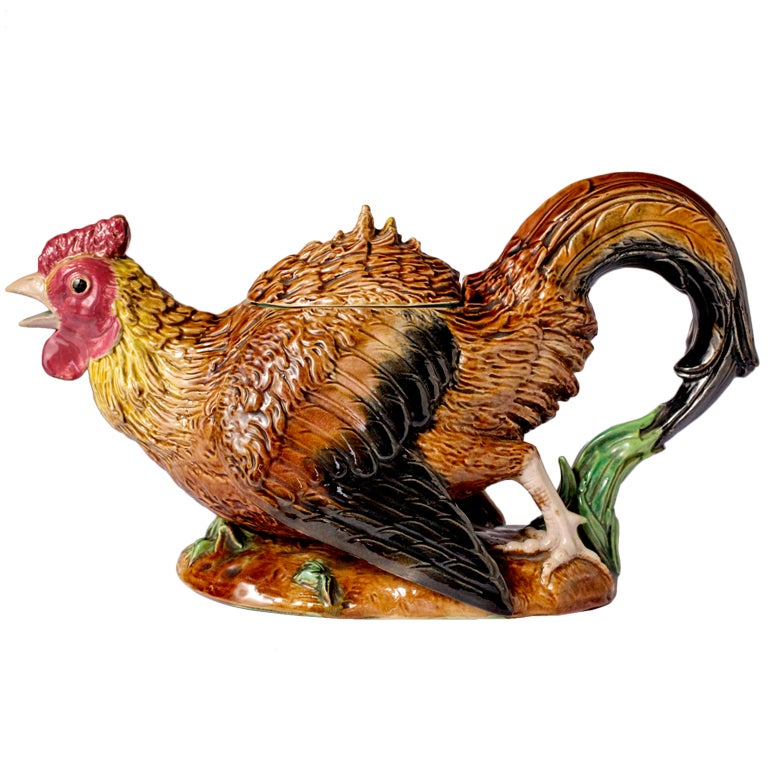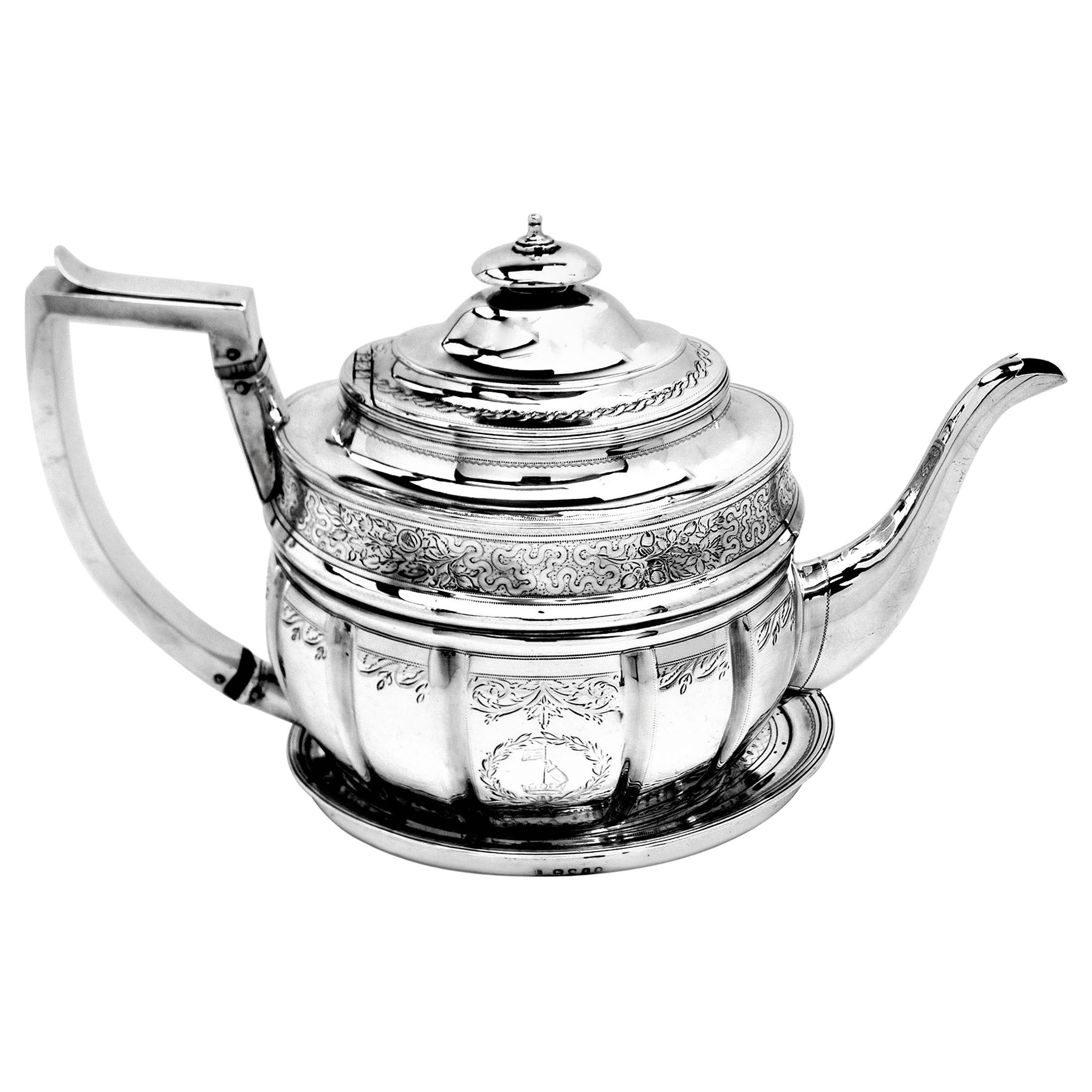Items Similar to exceptional George III teapot by preeminent silversmith Paul Storr, 1793
Want more images or videos?
Request additional images or videos from the seller
1 of 10
exceptional George III teapot by preeminent silversmith Paul Storr, 1793
About the Item
This rare and exceptional George III teapot is the work of preeminent Georgian silversmith Paul Storr, it is one of his earliest works, the date mark on this pieces of the year 1793 which is the first year Storr marked items with his own initials (P S)
The teapot is designed in the neoclassical taste with some Chinese influences, or Chinoiserie taste, even the figure on the cover of the teapot is Chinese.
It is very hard to impossible to find works from this early period with this interesting Royalty provenance.
The family crest on the front is of the Tollemache family, and dating of The teapot indicate It belonged and probably commissioned by or as a gift to William Manners Tollemache, Lord Huntingtower, William, On 12 January 1793, at the Age of 26, he Was created a Baronet, of Hanby Hall in the County of Lincoln.
So this teapot was commissioned to celebrate the occasion.
William Manners Tollemache:
Lord Huntingtower (19 May 1766 – 11 March 1833), known as Sir William Manners, Bt, between 1793 and 1821, was a British nobleman And Tory politician.
Born William Manners, he was the eldest son of John Manners and Louisa Tollemache, 7th Countess of Dysart. On 12 January 1793, at the age of 26, he was Ceated a Baronet, of Hanby Hall in the County of Lincoln.On his mother's Succession to the earldom in 1821, he was styled Lord Huntingtower, and adopted The surname of Talmash or Tollemache
Paul Storr:
(baptised 28 October 1770 in London – 18 March 1844 in London) was an English goldsmith and silversmith working in the Neoclassical and other styles During the late eighteenth and early nineteenth centuries. His works range from Simple tableware to magnificent sculptural pieces made for royalty
Paul Storr was England's most celebrated silversmith during the first half of the Nineteenth century and his legacy lives on today. His pieces historically and Currently adorn royal palaces and the finest stately homes throughout Europe and The world. Storr's reputation rests on his mastery of the grandiose neo-Classical Style developed in the Regency period. He quickly became the most prominent Silversmith of the nineteenth century, producing much of the silver purchased by King George III and King George IV. Storr entered his first mark in the first part of 1792, which reflects his short-lived partnership with William Frisbee. Soon after, he Began to use his PS mark, which he maintained throughout his career with only Minor changes. His first major work was a gold font commissioned by the Duke of Portland in 1797 and in 1799 he created the "Battle of the Nile Cup" for presentation To Lord Nelson.
Items from Storr's workshops may be seen at Windsor Castle and during the Summer opening season at Buckingham Palace. There are significant holdings of Items in the National Silver Collection at the Victoria and Albert Museum as well as In the Wellington Collection at Apsley House. Outside London there are important Works at Brighton Pavilion, at the Bowes Museum, Barnard Castle and at Woburn Abbey. In the United States there are holdings of Paul Storr at the Huntington Museum of Art, the Museum of Fine Arts, Boston, the Los Angeles County Museum Of Art, and the Metropolitan Museum of Art, New York, among others. The Birmingham Museum of Art in Alabama has two significant pieces. In Canada, there Are significant pieces in the Museum of Fine Arts, Montreal, and the Winnipeg Art Gallery, Winnipeg, Manitoba. Australia has holdings at the National Gallery of Victoria in Melbourne. In Portugal there is a fascinating group of silver made by Storr At the Casa-Museu Medeiros e Almeida, Lisbon, whereas in Russia, at the State Hermitage Museum, there is silver supplied to Tsar Nicholas I and members of the Aristocracy by Hunt & Roskell, successors to Storr & Mortimer
- Creator:Paul Storr (Artist)
- Dimensions:Height: 7 in (17.78 cm)Width: 6.7 in (17.02 cm)Depth: 11.2 in (28.45 cm)
- Style:Neoclassical (Of the Period)
- Materials and Techniques:
- Place of Origin:
- Period:1790-1799
- Date of Manufacture:1793
- Condition:Wear consistent with age and use. good condition, unrestored in any way, some minor scratched small dings but otherwise perfect for its age.
- Seller Location:Tel Aviv - Jaffa, IL
- Reference Number:1stDibs: LU8130237702992
Paul Storr
Paul Storr was an English goldsmith and silversmith working in the Neoclassical and other styles during the late 18th and early 19th centuries. His works range from simple tableware to magnificent sculptural pieces made for royalty. Storr is credited with perfecting the works, styles and designs of the Regency period. His legacy is a remarkable body of work that spans over several stylistic periods with far-reaching influences. From his Neo-classical masterpieces to his exuberant, ornate vessels, Storr imparted a level of craftsmanship and superior quality that has seldom been seen since.
About the Seller
No Reviews Yet
Vetted Seller
These experienced sellers undergo a comprehensive evaluation by our team of in-house experts.
1stDibs seller since 2023
Typical response time: 1 to 2 days
- ShippingRetrieving quote...Ships From: Tel Aviv - Jaffa, Israel
- Return PolicyThis item cannot be returned.
More From This SellerView All
- Antique early 20th Chinese Exceptional Solid Silver Teapot, Wu Hua物華, TianjinLocated in Tel Aviv - Jaffa, ILAntique early 20th Century exceptionally rare Chinese solid silver teapot, of traditional round form, the body finely engraved in traditional Chinese style, suggesting this teapot was made for the Chinese market. The body engraved with bamboo and butterflies , the unusual handle imitating bamboo, the removable lid set with a peach finial (Peaches are the symbol of longevity). According to Daoist lore, the peaches of immortality grew in the garden of the Queen Mother of the West - Xi Wangmu. the spout with a hedged cover in the shape of a lingzhi mushroom and a FU symbol of good furtune. the top frieze is decorated with 8 Chinese symbols: a scroll, a Ruyi scepter, a qin, The Endless Knot, a pendant, an old book, a wrist rest, and two overlapping squares. The teapot is very unusual, fine and exceptionally crisp. it is made of heavy Gauge silver and the attention to detail and design is simply outstanding. "WU HUA...Category
Early 20th Century Chinese Chinese Export Metalwork
MaterialsSilver
- Amazing Japanese silver teapot and cover, dragon spout Meiji period 19TH centuryLocated in Tel Aviv - Jaffa, ILamazing rare archaistic style silver ewer or tea pot with cover, the design is Of archaistic style dragons on the main frieze and on the cover, this style came from ancient Chinese a...Category
Antique 1890s Japanese Metalwork
MaterialsSilver
- Rare George iv Gilt-Silver Inkwell, Rundell and BridgeBy Rundell, Bridge & RundellLocated in Tel Aviv - Jaffa, ILVery rare and important piece of George IV silver, highly important silver-gilt Inkwell probably by John Bridge of the renowned silversmiths Rundell & Bridge, Royal Silversmiths to t...Category
Antique 1820s English Sterling Silver
MaterialsGold Plate, Silver
- Important Rothschild family French silver presentation plate by Maurice MayerLocated in Tel Aviv - Jaffa, ILextremely rare french silver presentation plate/ dinner plate. this important plate is one of the best quality work and engraving i have ever seen in my life, the outer rim is all adorned and ornate with flowers in neoclassical style, and the actual plate is all hand engraved with the most incredible engraving with gold plating on just the engraved patterns what makes the plate looks like the gold plated part is 3 dimensional. This important plate was made in paris by the famous silver master Maurice Mayer...Category
Antique Late 19th Century French Neoclassical Sterling Silver
MaterialsGold Plate, Silver
- Satsuma earthenware vase by kinkozan, Meiji periodBy KinkozanLocated in Tel Aviv - Jaffa, ILthe body of this small marvelous vase is painted with a scene of a puppet show vendor with his wood backpack, on top of the backpack there are toys and dolls, he is surrounded with a group of 6 children, and on the background you can see a village. on the other side of the vase there is an amazing painting of flowers and on the sides there are two amazing strong pine trees, the amorphous background is decorated in a "Tortoiseshell" color and design that gives it a real character and which is quite rare to see on satsuma pottery. all the vase is over richly overpainted over the glaze with gold, which gives it its depth and realism. signed Kyoto Kinkozan zo, and sealed Kinkozan zo Kyoto’s Satsuma: The painting technique used in Kyoto’s Satsuma-style ware is said to be the invention of the sixth generation Kinkōzan Sōbei (1824–1884). The Kinkōzan were a famous family of Kyoto Awataguchi potters who made ceramics that were used at Shōren'in, a temple closely tied to the imperial family, and by the shoguns of the Edo government. In fact the shogun is said to have granted them the name Kinkōzan. With the upheavals at the end of the Edo period, however, and the reforms of the subsequent Meiji government, the potters lost their traditional patrons and had to develop new markets. Just at that time, the visit of a certain Westerner is said to have decided them to embark on overseas trade. By 1870, they had perfected Kyō Satsuma...Category
Antique 1890s Japanese Meiji Ceramics
MaterialsGold
- Decorative Judaica Passover plate by Heinrich Schwed. Munich, 1924.Located in Tel Aviv - Jaffa, ILDecorative Passover plate by Heinrich Schwed. Munich, 1924. ALPACA, etched. This Large plate, featuring a round medallion in the center, with a Matzah which in this plate is hand c...Category
Vintage 1920s Platters and Serveware
MaterialsAlpaca
You May Also Like
- 19th Century Antique George III Sterling Silver Tea Urn London 1813 Paul StorrBy Paul StorrLocated in London, GBA truly stunning silver hemispherical tea urn decorated with gadroon borders for highlights. The body has a stylish upper girdled wire and a ‘serpent’ themed tap. The lion mane ha...Category
Antique 1810s British Regency Tea Sets
MaterialsSilver
- 19th Century Paul Storr Silver Tea UrnBy Paul Storr, Rundell, Bridge & RundellLocated in New Orleans, LAThis extraordinarily rare and masterfully crafted tea urn is by the hand of the master Georgian silversmith Paul Storr. Created by Storr while working for Rundell, Bridge and Rundell, Jewelers and Goldsmiths to the King, this magnificent piece truly represents the sophisticated style of the renowned firm and the enormous talents of Paul Storr. Applied and engraved decoration envelop this masterpiece equipped with a carved handle, lion's head spigot and spectacular lion's paw supports. The piece bears the arms of the Neave Baronetcy with those of Digby, for Sir Thomas Neave and his wife Frances Caroline, daughter of the Hon. William Digby, the Dean of Durham. Though he held no formal title, Storr enjoyed patronage from the most important and powerful figures of the period including King George III and the Prince of Wales, the future King George IV. His first major work was a gold font commissioned by the Duke of Portland in 1797, and in 1799 he created the “Battle of the Nile...Category
Antique 19th Century English Georgian Sterling Silver
MaterialsSilver
- George III antique silver teapot by Hester BatemanBy Hester BatemanLocated in London, GBClassic late George III period antique silver teapot made by acclaimed female silversmith, Hester Bateman. The teapot features her signature bead...Category
Antique 18th Century British George III Tea Sets
MaterialsSterling Silver
- George Jones Rooster TeapotBy George JonesLocated in New York, NYRare George Jones majolica teapot shaped like a crowing cockerel. Whimsical English design with realistic feathered lid, curved tail handl...Category
20th Century English Tea Sets
MaterialsMajolica
- Antique George III Georgian Silver Teapot on Stand 1804 Tea PotBy Crispin FullerLocated in London, GBAn Antique George III solid Silver Teapot on Stand decorated with a delicate engraved design on the Teapot and on the Oval Tray below. The Teapo...Category
Antique Early 19th Century English Georgian Tea Sets
MaterialsSterling Silver
- Antique George III Sterling Silver Salver by Paul Storr 1811 19th CenturyBy Paul StorrLocated in London, GBThis is a wonderful English antique George III sterling silver 10 inch salver, by the world famous silversmith Paul Storr. It has clear hallmarks for London 1811 and the makers mark of Paul Storr. It is typical of his work with the raised gadrooned rim with anthemion at intervals, on four fabulous foliate bracket feet. The salver is engraved with a crest and motto and the underside is later engraved Charlotte J. Parke from C. J. Parke, March 1893' The centre is engraved with a crest above a motto 'True and Fast' and I have researched this crest: The Crest of Parke The crest as engraved upon this George III English Sterling Silver Footed Salver by Paul Storr hallmarked London 1811 is that of the family of Parke. It may be blazoned as follows: Crest: A stag’s head couped sable holding in the mouth a key or Motto: True and fast The family of Parke originally hailed from the County of Cumberland in the northeast of England1 later settling in the County of Dorset at Henbury House, Sturminster Marshal, near Wimborne. Given the evidence of the inscription found on the underside of the salver ‘Charlotte J. Parke from C. J. Parke, March 1893’ it was undoubtedly at one time in the possession of Charles Joseph Parke (died 9th March 1893) of Henbury House aforesaid and gifted to Charlotte Josephine Parke (baptised 4th January 1857 died 2nd January 1941) his third daughter by his wife, Ellen Mary Ethelston. I would venture the following hypothesis that the salver was bequeathed to Charlotte in her father’s will that was granted probate at London on the 20th May 1893. The ‘March 1893’ of the inscription acts as a remembrance of the month of the death of her father. It was noted that Charlotte’s father left an estate worth some £66,892, 19 shillings and one pence, a very considerable sum in the last decade of the 19th Century and even thereafter. Charlotte never married and was living at the time of her death at The Coppice, Sixpenny Handley in the County of Dorset. Her will was proved for probate at Llandudno on the 25th March 1941. She left an estate worth £18,866, 10 shillings and 4 pence. Again, a comfortable sum in 1941. See the photo of Henbury House, Sturminster Marshal, near Wimborne, Co. Dorset. The former seat of the Parke family. The house was destroyed by fire, the remains of which were demolished in the 1990's. There is no mistaking its unique quality and design, which is sure to make it a treasured piece by any discerning collector. Condition: In excellent condition with clear hallmarks and no dings, dents or signs of repair. Please see photos for confirmation. Dimensions in cm: Height 2 x Width 26.5 x Depth 26.5 Weight 0.69 kg Dimensions in inches: Height 1 inch x Width 10 inches x Depth 10 inches Weight 1.5 lbs Paul Storr born in London England in 1771, was to become one of the most talented silversmiths of the nineteenth century. Today his legacy of exceptionally well crafted silver, found worldwide in museums and private collections, leaves one in awe when compared to that of his contemporaries.After having served a seven year apprenticeship from the age of 14, he began his career in 1792 when he went into a brief partnership with William Frisbee. This did not last and in 1793 a new mark, (his initials ‘P S’) was entered. By the beginning of the nineteenth century he had established himself as one of London’s top silversmiths producing, amongst others, commissions for Royalty. In 1801 he married Elizabeth Susanna Beyer with whom he was to have ten children. In 1807 Paul Storr entered into a working relationship with Philip Rundell and by 1811 was a partner, and managing the workshops for Rundell, Bridge & Rundell. During this period he kept his own marks and separate workshop. However it was through Rundell, Bridge & Rundell who were appointed Goldsmith in Ordinary to George III in 1804 that his reputation as a master silversmith grew. His talents lay in being able to transform ideas and designs from Rundell, Bridge & Rundell’s designers, William Theed...Category
Antique 1810s English George III Sterling Silver
MaterialsSterling Silver
